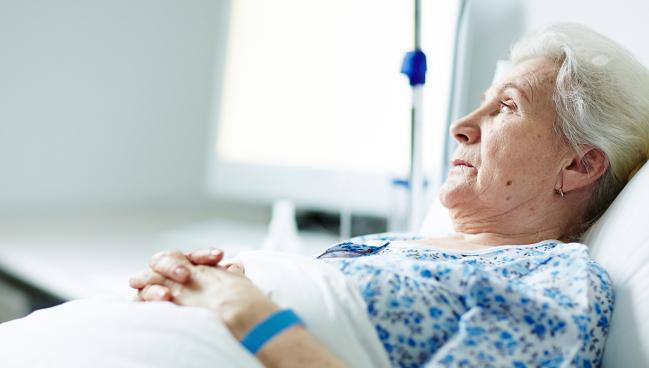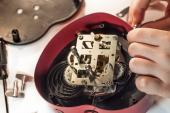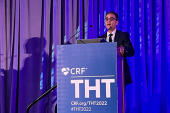REDUCE LAP-HF II Subanalysis Makes the Case for Invasive Exercise Tests
The findings may spur trialists to consider invasive hemodynamics to explore HFpEF phenotypes, says Michelle Kittleson.

Identifying exercise-induced left atrial hypertension (EILAH) in patients who have heart failure with preserved ejection fraction (HFpEF) requires specialized invasive tests, but because the phenotype affects about one-third of this population—leading to similar symptom severity but less advanced myocardial and pulmonary vascular disease—researchers working in the interatrial shunt space are arguing for more identification and awareness.
The main REDUCE LAP-HF II trial, as reported last year by TCTMD, showed no benefit of atrial shunting with the IASD System II (Corvia Medical) compared with a sham procedure in terms of reducing HF events or improving health status in patients with HFpEF. Invasive exercise testing, however, identified a responder group—those without latent pulmonary vascular disease—who appeared to do better with shunt placement.
In this new analysis, investigators showed that, based on invasive hemodynamics, almost a third of REDUCE LAP-HF II patients were found to have normal pulmonary capillary wedge pressures (PCWP) at rest but not during exercise.
“That is important because many places do not do exercise hemodynamics,” said Sheldon E. Litwin, MD (Medical University of South Carolina, Charleston), who presented the findings at the Technology and Heart Failure Therapeutics (THT) 2023 meeting. “The fact that there is a high percentage of them that look normal, and you only unmask it with exercise—that is the important finding,” he told TCTMD. “That did not necessarily surprise me, but I am not sure if that is widely recognized.”
It also hasn’t been previously appreciated that this population has several characteristics to suggest that they might have an earlier-stage or less-advanced disease compared with those with resting LA hypertension (RELAH), Litwin said. “They had a lot of things that would indicate that they have not developed a lot of structural disease. To me, that is important because there is a sort of big debate in the field about which patients should be enrolled in these clinical trials.”
While some argue for the sickest patients because they have the most potential for benefit, it’s also likely that once patients are sick, it is that much harder to reverse the disease process, according to Litwin. “Maybe we’re better off treating patients earlier when their heart is still salvageable, recoverable, [as well as] the heart and/or pulmonary vasculature,” he said. “I think that was a new insight that maybe I realized a little bit, but not entirely.”
While the study is a “a step in the right direction to understanding the subtleties of different phenotypes of HFpEF,” Michelle M. Kittleson, MD, PhD (Cedars-Sinai Hospital, Los Angeles, CA), who was not involved in the analysis, commented to TCTMD that the findings are not yet clinically actionable.
“It supports our suspicion as clinicians that this is a very hard condition to diagnose, that the patient sitting in front of you might look great, might have a certain degree of symptoms, but you don't really know what is going on until you do an exercise test to look at what happens to their pressures with exercise,” she said. “Now that being said, I am not at the point where I think we can advocate adding exercise stress testing as an important test for clinicians to do for their patients who present with dyspnea and or edema and a ‘normal’ echocardiogram where the ejection fraction is preserved. We're not there yet because even if you do that [and] you figure out they’re EILAH vs RELAH, what do you do with that information?”
Determining a patient’s phenotype will certainly be helpful for clinical trialists at this point, however, especially given how heterogeneous the underlying HFpEF population is, Kittleson added.
EILAH and RELAH
In the subanalysis, which was simultaneously published in JACC: Heart Failure, Litwin and colleagues looked at the 626 patients (mean age 72 years; 61.5% female) with EF ≥ 40% and exercise PCWP ≥ 25 mm Hg who were randomized to undergo atrial shunting or a sham procedure.
The invasive exercise test for all patients involved measuring both the right heart and pulmonary artery pressures using a fluid-filled catheter at rest, in a legs up position, and during exercise with a supine bicycle ergometer through graded increments of 3 minutes each until peak output was reached.
Among the 29% of patients with EILAH (defined as resting PCWP < 15 mm Hg) in REDUCE LAP-HF II, symptom severity was similar to those with RELAH (defined as resting PCWP ≥ 15 mm Hg), but they had lower natriuretic peptide levels, further 6-minute walk distance, less atrial fibrillation, lower LV mass, smaller left atrial volumes, lower E/e’ ratio, and better LA strain. EILAH patients were also slightly younger on average and less likely to have hypertension, diabetes, chronic kidney disease, and A-fib.
In general, PCWP was lower at rest for both patients with EILAH as well as with those with RELAH, but there was a larger increase with exercise in EILAH. Comparing those who underwent shunt therapy compared with a sham procedure, neither group saw a significant effect. However, those with EILAH were more likely to have characteristics associated with atrial shunt responsiveness, including peak pulmonary vascular resistance < 1.74 Wood units and no pacemaker (63% vs 46%; P < 0.001).
The win ratio for the primary trial outcome—a hierarchical composite of death, HF hospitalization, intensification of diuretics, and change in health status—was 1.56 (P = 0.08) in EILAH and 1.51 (P = 0.04) in RELAH patients with responder characteristics.
Litwin would like to see these data first inform patient selection for future trials of atrial shunting to best determine who would most benefit. “Of course, that is a big question because there are a lot of people who raise their eyebrows when we say we want to make a hole in the heart, because in the past, we have always closed holes when we find them,” he said.
Clinically, it will be important to look into how a device-based therapy can be best combined with drugs going forward. “Maybe the device will allow you to either get people off of drugs that they no longer need or to get them on drugs that could be helpful that they were not able to tolerate in the past,” Litwin said. “That is a new way of thinking, and the idea of complementary or stacking therapies is one that almost certainly is going to get explored more in the future.”
For now, his main message to clinicians is that “doing invasive pressure measurements at rest and with exercise can be really, really helpful.”
Further Understanding Needed
In an accompanying editorial, Mathew S. Maurer, MD, and Hannah R. Rosenblum, MD (both NewYork-Presbyterian/Columbia University Irving Medical Center, New York, NY), write that because the study has “shown us how common HFpEF with EILAH is and how to identify affected individuals, we need to further understand this phenotype and how to address it.”
Doing so will take some time, according to Kittleson. “We are in a very exciting time in the world of HFpEF,” she said, with beneficial medications like SGLT-2 inhibitors finally available. “It is incredibly important to make the diagnosis so you can give your patient a therapy that actually works, but we know [trials like] EMPEROR-Preserved and DELIVER did not specify EILAH versus RELAH [and] we have no clinically actionable information to say EILAH versus RELAH should change what we do for patients.”
That said, she continued, if a clinician is “on the fence” about whether a patient might have HFpEF and would be a good candidate for an SGLT-2 inhibitor, performing an invasive exercise stress test to “uncover the physiology to solidify your diagnosis” might be useful. “But again, I think that is going to be a small subset of patients, because actually knowing EILAH versus RELAH is not going to change what you do,” Kittleson said.
But knowing how common EILAH is, she continued, “is actually very encouraging because it means that you can enrich your clinical trial populations based on phenotypes to find therapies that are that are beneficial.”
Yael L. Maxwell is Senior Medical Journalist for TCTMD and Section Editor of TCTMD's Fellows Forum. She served as the inaugural…
Read Full BioSources
Litwin SE, Komtebedde J, Hu M, et al. Exercise-induced left atrial hypertension in heart failure with preserved ejection fraction. J Am Coll Cardiol HF. 2023;Epub ahead of print.
Maurer MS, Rosenblum HR. Difficult diagnoses are often undertreated: the case of HFpEF with exercise-induced left atrial hypertension. J Am Coll Cardiol HF. 2023;Epub ahead of print.
Disclosures
- Litwin reports receiving research funding from the department of Veterans Affairs, Corvia, AstraZeneca, V-Wave, Axon Therapeutics, and Eli Lilly all paid to the institution. He has received consulting fees from CVRx, Axon Therapeutics, Occlutech, Eli Lilly and Rivus pharmaceuticals.
- Maurer and Rosenblum report no relevant conflicts of interest.





Comments